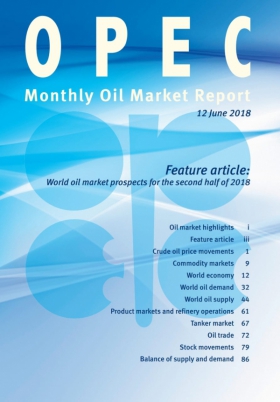OPEC Success Won’t Lead to an Artificial Price Rise

Last year, with incorrect perceptions of global oil production and deliberate pessimism in regards to worldwide oil demand, the western oil media tried to dictate and articulate the artificial failure of OPEC’s efforts to balance oil markets. This was intended to keep oil prices at low levels. The goal was for a bear oil market to continue with a resultant state of tension and instability. Every attempt was made to promote a weakening of market trends through highlighting irrelevant information or misrepresenting facts.
At the close of the week of April 20, 2018, Brent crude reached $74/bbl, which is the highest level since late 2014. Such upward movement came after strong fundamentals showed market tightness that spurred record levels of speculative traders, nearly all betting on higher prices. It also recognized that total US inventories are below the five-year average for the first time since May 2014. So how can this be an artificial movement in oil prices, which have been trending upward gradually with gentle fluctuations not in steep surges or declines?
The Brent/WTI spread has widened enormously to $5.66/bbl, which spurred US oil exports everywhere. This emphasizes that the US shale oil industry benefited the most from the rise in oil prices, where the US production growth is welcomed to meet the rising global demand.
So let’s take a look at the current state of the global oil demand/supply balance. The International Energy Agency (IEA) noted that since May 2017, global oil stocks have fallen constantly. Global oil stocks are now only 30 million barrels above the five-year average level and product stocks are below that level. The IEA believes that in the next couple of months OECD oil stocks will fall below the five-year average. Such a reduction in oil stocks is occurring despite an increase in global output that is currently 1.4 million barrels per day higher than a year ago, mostly as a result of higher US production.
In reality, global oil inventories peaked in 2016. Inventories have been falling since then despite American producers pumping at all-time highs, which have kept oil prices at artificially low levels. Due to a lack of investment in the oil industry, the IEA predicts that spare production capacity in 2022 will fall to a 14-year low. Saudi Aramco noted that globally about $1 trillion in investments were lost since 2014 due to the start of the decline in oil prices. The oil giant urged more investment to maintain supply, stating that it would be investing $300 billion over the coming decade.
Global oil markets are rebalancing. That will continue through 2018 as a result of a substantial supply deficit. As a result, oil prices have started an upward momentum since the end of October 2017. They went above the psychological barrier $60/bbl after 10 consecutive months of tireless efforts by OPEC and non-OPEC.
Such upward momentum in oil prices isn’t artificial movement because it came after many months without steep price fluctuations. In 2016, the Brent price average was $43/bbl. The 2017 Brent price average was $54/bbl, and prices just surpassed the $60/bbl in October 2017. The Brent average surpassed $70/bbl in late March 2018 and has been hovering at that level since then. There is no evidence of a steep fluctuation or an artificial movement.
The claims of an artificial price movement have come just at the time when OPEC and the world are reaping the positive outcomes of 24 nations collaborating in output cuts that managed to successfully rebalance the oil market amidst a situation where global oil inventories were running at record highs. Also, these false claims came when the oil industry needs capital inflows to reactivate upstream investments for major international oil companies. Such investments are essential for the price stability that benefits oil producers and consumers. Intuitively, low oil prices result in low investment in discovery and production of petroleum resources, which damage various industry sectors and energy needs. That leads to a vicious cycle of up and down price fluctuations which harm everyone except speculators.
Dr. Faisal Mrza
@faisalmrza
Energy and Oil Marketing Adviser (Former OPEC / Saudi Aramco)




